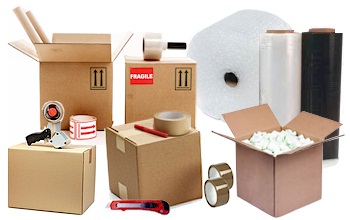Moving to a new home or office is exciting, but it can also be stressful—especially when it comes to packing. Using the right packing materials is one of the simplest ways to ensure your belongings stay safe, organized, and damage-free during transport. In this complete guide, we’ll walk you through all the packing material essentials you need for a smooth, stress-free moving experience.
Introduction
When it’s time to move, the biggest challenge is keeping your belongings protected from scratches, cracks, and breakage. Choosing high-quality packing materials can make the entire process easier, faster, and more efficient. This guide will help you understand what materials you need, how to use them correctly, and how to avoid common mistakes people make while packing.
Why Quality Packing Material Matters
Many people underestimate the importance of reliable packing supplies. Poor-quality boxes or cheap tape can easily fall apart, putting your valuables at risk. Here’s why investing in good packing material is essential:
-
Better Protection: A sturdy box or cushioned wrapper can prevent damage to fragile items.
-
Time Saving: Organized packing minimizes confusion during unpacking.
-
Reduced Stress: With secure packing, you worry less about items shifting or breaking.
-
Cost-Effective: Avoid extra expenses caused by damaged belongings during the move.
Essential Packing Materials You Must Have
Cardboard Boxes
Cardboard boxes are the foundation of any move. Different sizes serve different purposes:
-
Small Boxes: Perfect for canned foods, books, or tools.
-
Medium Boxes: Ideal for clothes, kitchenware, and decor.
-
Large Boxes: Great for lightweight, bulky items like pillows and blankets.
-
Wardrobe Boxes: Come with a hanging bar for transporting clothes without creasing.
-
Dish-Pack Boxes: Extra-strong boxes for plates, glasses, and ceramics.
Bubble Wrap
Bubble wrap is essential for fragile belongings. The air-filled pockets cushion delicate surfaces and absorb shocks during transport. Larger bubbles work best for electronics and decor, while smaller bubbles suit glassware and small fragile items.
Packing Paper
Packing paper is cleaner and more protective than newspaper, which can leave ink stains. Use it for wrapping plates, dishes, and fragile pieces or filling gaps inside boxes to prevent movement.
Packing Tape
High-quality tape ensures your boxes stay sealed from start to finish. Popular options include:
-
Heavy-Duty Tape: Best for heavy boxes.
-
Water-Resistant Tape: Great for outdoor or long-distance moves.
-
Easy-Tear Tape: Convenient for quick packing.
Stretch Wrap (Plastic Wrap)
Stretch wrap is perfect for:
-
Keeping drawers and doors closed
-
Protecting furniture from scratches
-
Securing loose items together
It clings tightly, adding an extra layer of protection without leaving residue.
Foam Sheets & Foam Rolls
Foam is excellent for dishes, picture frames, glassware, and other delicate surfaces. Foam sheets slip easily between items while foam rolls provide thick cushioning for larger or more sensitive pieces.
Moving Blankets
Moving blankets offer heavy-duty protection ideal for large furniture and appliances. They help prevent dents, scratches, and damage during lifting and transit.
Labels & Markers
Labeling is one of the biggest time-savers during unpacking. Use markers or color-coded labels to categorize boxes—for example, red for kitchen, blue for bedroom, yellow for living room.
Specialized Packing Materials for Extra Protection
Sometimes standard supplies aren’t enough—especially for sensitive or expensive items. Here are advanced options:
-
Corner Protectors: Perfect for mirrors, TVs, frames, and furniture edges.
-
Mattress Covers: Keep mattresses free from dirt, stains, and moisture.
-
Sofa & Furniture Covers: Protect upholstery from dust and damage.
-
Crates: Heavy-duty wooden or plastic crates for artwork, electronics, or valuable items.
-
Anti-Static Wrap: A must for computer parts and electronics to prevent static shock damage.
How to Choose the Right Packing Materials
Not every item needs the same level of protection. Here’s how to choose wisely:
-
Item Weight: Heavy items require small, sturdy boxes.
-
Fragility: More delicate items need bubble wrap or foam.
-
Size: Larger items may need blankets or stretch wrap.
-
Budget: Focus on essentials but avoid low-quality materials that may break easily.
-
Reusability: Some materials like moving blankets and crates can be reused multiple times.
Cost-Saving Tips for Buying Packing Materials
You don’t have to spend a lot to pack efficiently. Here’s how to save:
-
Buy in Bulk: Cheaper rates for boxes, tapes, and wraps.
-
Reuse Materials: Use old blankets, towels, or boxes in good condition.
-
Compare Prices: Check online and in-store discounts.
-
Avoid Low-Quality Supplies: Cheap boxes may tear and cost you more if items break.
Step-by-Step Packing Tips for a Smooth Move
Follow these simple steps for easy, organized packing:
1. Pack Room by Room
This keeps things organized and easy to unpack.
2. Wrap Fragile Items Properly
Use bubble wrap, packing paper, and foam for complete protection.
3. Place Heavy Items at the Bottom
Light items should go on top to prevent crushing.
4. Seal Boxes Securely
Use at least two layers of tape at the bottom and top.
5. Label Every Box
Mark the room name, contents, and “Fragile” if needed.
Common Packing Mistakes to Avoid
Avoid these mistakes to ensure a hassle-free move:
-
Overpacking Boxes: Makes them too heavy and prone to breaking.
-
Using Weak Tape: Boxes may open during transport.
-
Not Labeling Boxes: Causes confusion while unpacking.
-
Ignoring Fragile Instructions: Leads to avoidable breakage.
Conclusion
Packing doesn’t have to be stressful. With the right packing materials, you can protect your belongings, stay organized, and enjoy peace of mind throughout your move. Start early, use quality supplies, and pack carefully to ensure everything arrives safely at your new destination.

